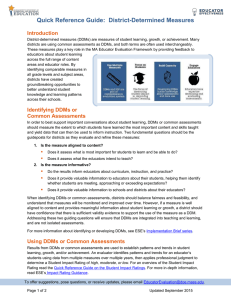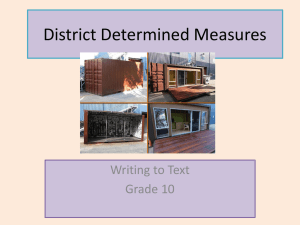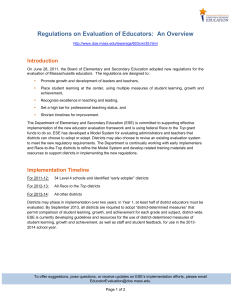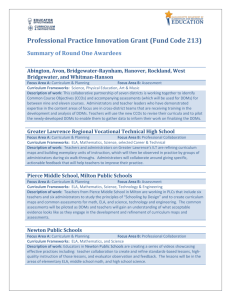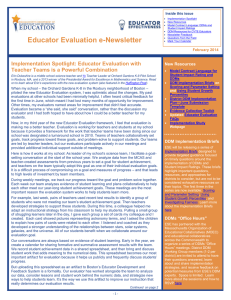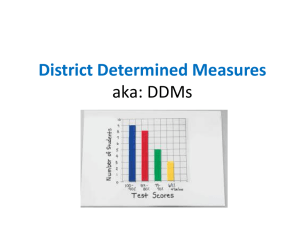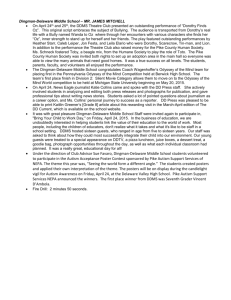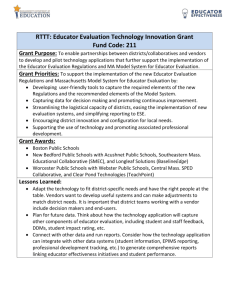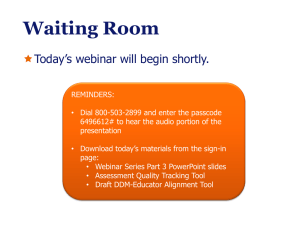Quick Reference Guide District
advertisement
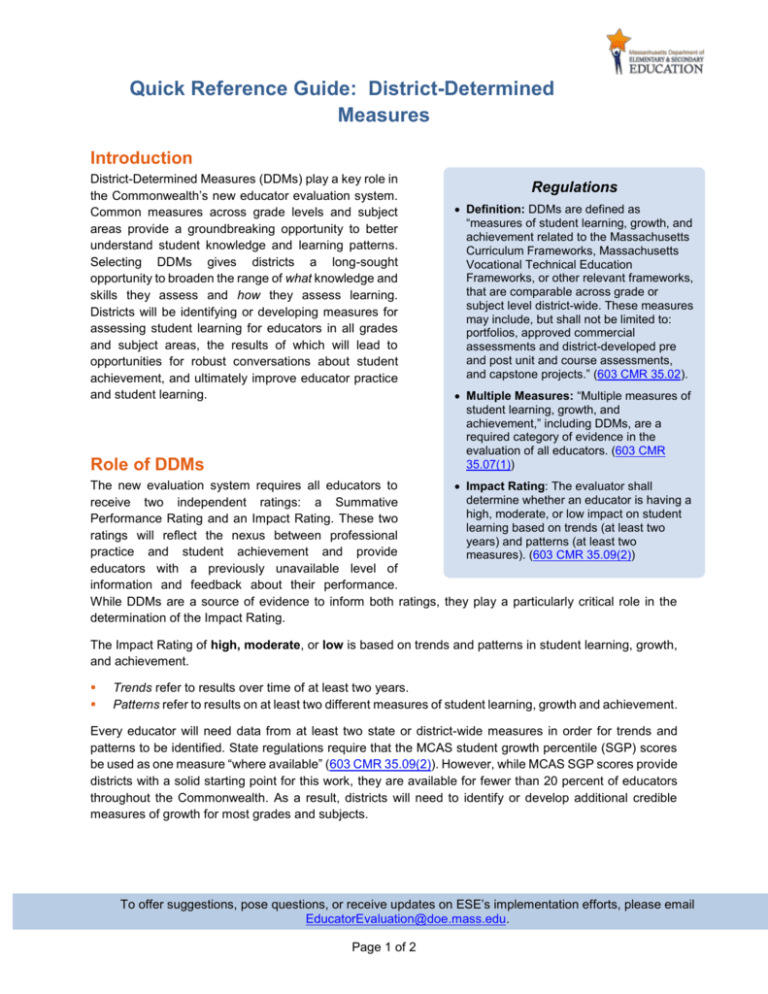
Quick Reference Guide: District-Determined Measures Introduction District-Determined Measures (DDMs) play a key role in the Commonwealth’s new educator evaluation system. Common measures across grade levels and subject areas provide a groundbreaking opportunity to better understand student knowledge and learning patterns. Selecting DDMs gives districts a long-sought opportunity to broaden the range of what knowledge and skills they assess and how they assess learning. Districts will be identifying or developing measures for assessing student learning for educators in all grades and subject areas, the results of which will lead to opportunities for robust conversations about student achievement, and ultimately improve educator practice and student learning. Role of DDMs Regulations Definition: DDMs are defined as “measures of student learning, growth, and achievement related to the Massachusetts Curriculum Frameworks, Massachusetts Vocational Technical Education Frameworks, or other relevant frameworks, that are comparable across grade or subject level district-wide. These measures may include, but shall not be limited to: portfolios, approved commercial assessments and district-developed pre and post unit and course assessments, and capstone projects.” (603 CMR 35.02). Multiple Measures: “Multiple measures of student learning, growth, and achievement,” including DDMs, are a required category of evidence in the evaluation of all educators. (603 CMR 35.07(1)) The new evaluation system requires all educators to Impact Rating: The evaluator shall determine whether an educator is having a receive two independent ratings: a Summative high, moderate, or low impact on student Performance Rating and an Impact Rating. These two learning based on trends (at least two ratings will reflect the nexus between professional years) and patterns (at least two practice and student achievement and provide measures). (603 CMR 35.09(2)) educators with a previously unavailable level of information and feedback about their performance. While DDMs are a source of evidence to inform both ratings, they play a particularly critical role in the determination of the Impact Rating. The Impact Rating of high, moderate, or low is based on trends and patterns in student learning, growth, and achievement. Trends refer to results over time of at least two years. Patterns refer to results on at least two different measures of student learning, growth and achievement. Every educator will need data from at least two state or district-wide measures in order for trends and patterns to be identified. State regulations require that the MCAS student growth percentile (SGP) scores be used as one measure “where available” (603 CMR 35.09(2)). However, while MCAS SGP scores provide districts with a solid starting point for this work, they are available for fewer than 20 percent of educators throughout the Commonwealth. As a result, districts will need to identify or develop additional credible measures of growth for most grades and subjects. To offer suggestions, pose questions, or receive updates on ESE’s implementation efforts, please email EducatorEvaluation@doe.mass.edu. Page 1 of 2 Quick Reference Guide: District-Determined Measures Revised Implementation Timeline In 2013-2014, all districts must research and pilot DDMs for some grades and subjects. o At a minimum, districts must pilot at least one DDM that is aligned to the Massachusetts Curriculum Frameworks in each of the following areas: (1) early grade (K-3) literacy, (2) early (K-3) grade math, (3) middle grade (5-8) math, (4) high school writing to text, and (5) traditionally non-tested grades and subjects (e.g., fine arts, music, p.e.). By September 2013, all districts must report to ESE: o The identified potential DDMs the district will pilot during the 2013-2014 school year and the grades and subjects to which they are aligned; o The grades and subjects for which the district has not identified potential DDMs and will research and/or develop measures to pilot in spring 2014. By February 2014, districts must report a final plan for determining Impact Ratings for all educators by the end of the 2015-2016 school year based on the identified DDMs. District Planning Activities Districts should be actively engaged in the process of identifying and selecting appropriate DDMs. The following suggested steps will help districts position themselves for success: Identify a team of administrators, teachers and specialists to focus and plan the district’s work on DDMs. Assess educators’ understanding of the basics of how the MCAS Student Growth Percentile is derived and how it can be used to understand student growth and progress; develop a plan for ensuring educator understanding. Complete an inventory of existing assessments used in the district’s schools and assess where there are strengths to build on and gaps to fill. Discuss with the district’s educational collaborative, or other district partner, its interest and capacity to assist member districts in the work of Learn More About identifying and evaluating assessments that may serve as DDMs. DDMs: Plan a process for piloting DDMs where potential measures have been identified. Part VII: Rating Educator Plan a process for researching and/or developing measures where no Impact on Student Learning existing measures are deemed appropriate. Using District-Determined Create (or augment) the district’s communication plan to ensure that educators, school board members, and other stakeholders understand the Measures of Student role that DDMs will play in the new evaluation framework as well as a Learning timetable for implementation. ESE’s Assessment Literacy ESE Supports Webinar Series To assist districts with the implementation of DDMs, ESE will continue to Revised Implementation provide support and technical assistance through every step of the process. Timeline - Commissioner's For example, through partnerships with assessment experts, ESE will collect, Memorandum, dated evaluate, and publish assessments that districts may choose to use as DDMs. 4/12/13 These prototype assessments are targeted for release this summer. Districts will be able to adopt/adapt assessments from this collection. ESE will also release technical guides to assist in identifying and selecting growth measures, and publish model collective bargaining language as well as additional guidance about topics such as teacher attribution, roster verification and determining impact ratings beginning this spring. To offer suggestions, pose questions, or receive updates on ESE’s implementation efforts, please email EducatorEvaluation@doe.mass.edu. Page 2 of 2
